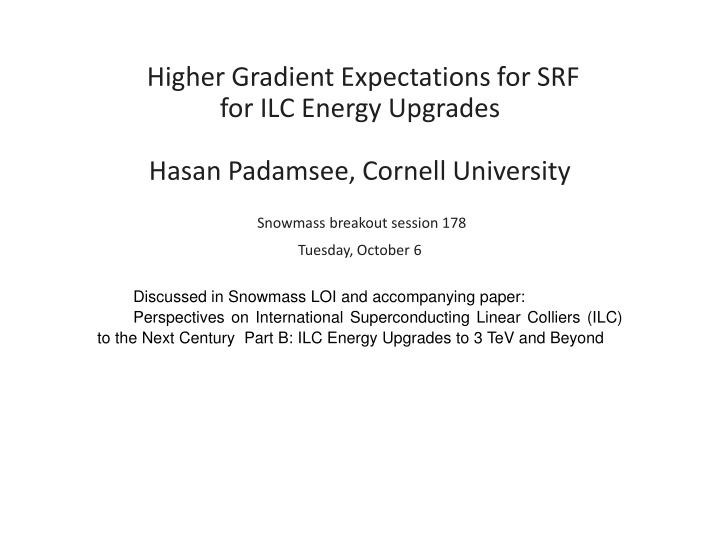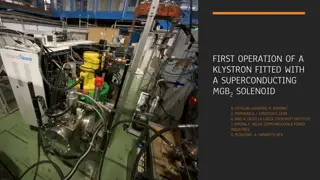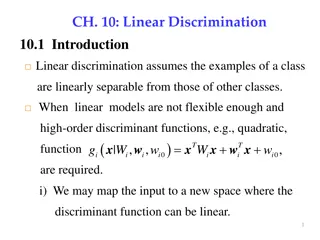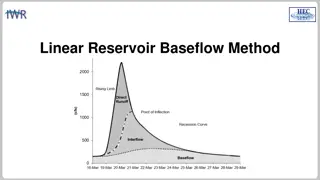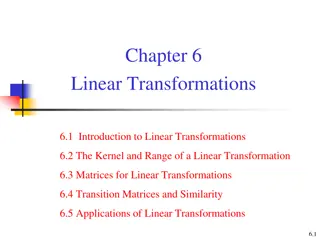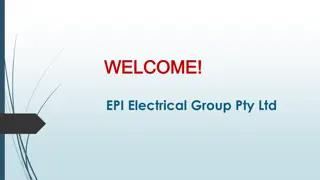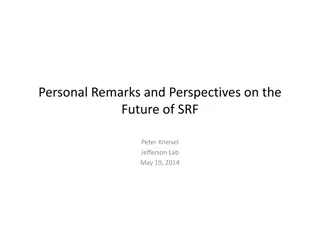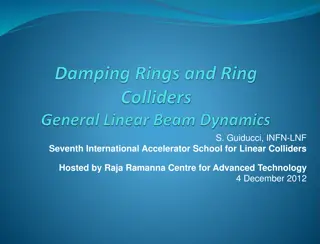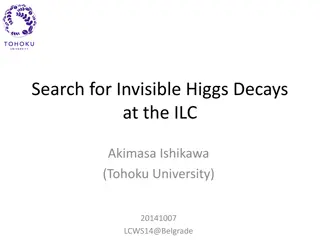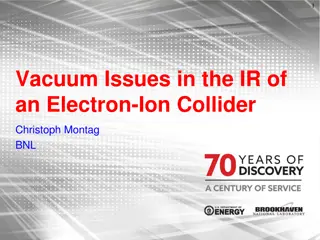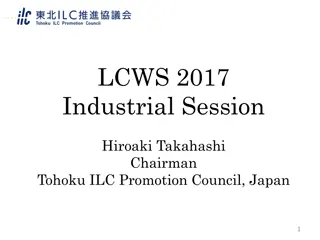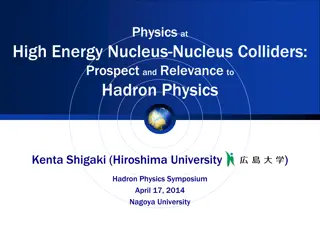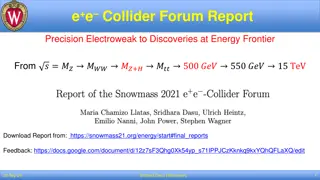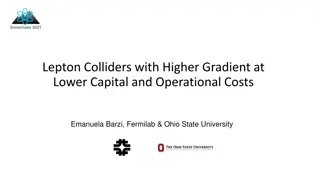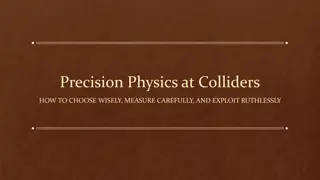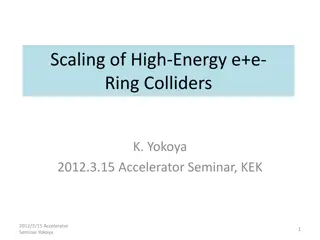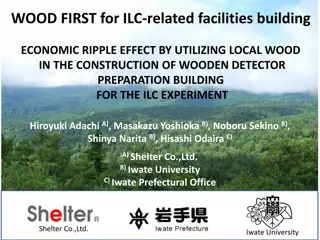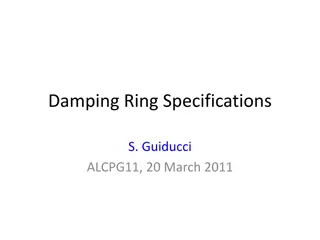Advancements in Superconducting Linear Colliders for ILC Energy Upgrades
Discussion on higher gradient expectations for SRF at the International Linear Collider (ILC) for energy upgrades beyond 3 TeV, highlighting advancements in single and multi-cell cavity gradients over three decades. Promising R&D paths include cold electropolishing, nitrogen infusion, advanced cavity shapes, and high Tc superconductors. Notable results from DESY show improved performance in large grain Nb 9-cell cavities. Various methodologies, such as advanced cavity shapes and cold EP/two-step baking, aim to achieve near 50 MV/m gradients for optimal ILC technology.
Download Presentation

Please find below an Image/Link to download the presentation.
The content on the website is provided AS IS for your information and personal use only. It may not be sold, licensed, or shared on other websites without obtaining consent from the author.If you encounter any issues during the download, it is possible that the publisher has removed the file from their server.
You are allowed to download the files provided on this website for personal or commercial use, subject to the condition that they are used lawfully. All files are the property of their respective owners.
The content on the website is provided AS IS for your information and personal use only. It may not be sold, licensed, or shared on other websites without obtaining consent from the author.
E N D
Presentation Transcript
Higher Gradient Expectations for SRF for ILC Energy Upgrades Hasan Padamsee, Cornell University Snowmass breakout session 178 Tuesday, October 6 Discussed in Snowmass LOI and accompanying paper: Perspectives on International Superconducting Linear Colliers (ILC) to the Next Century Part B: ILC Energy Upgrades to 3 TeV and Beyond
General Remarks Best gradient for ILC start at 250 GeV is 31.5 MV/m Gradient improvement prospects discussed here are generally based on new techniques under development with proof-of-principle results established with single cell cavities As the next slide shows: 3+ decades of SRF R&D show that 9-cell cavity gradients follow 1-cells - with about a decade time lag Time lag depends on R&D funding levels And competition for resources to apply technology to funded accelerator projects
Steady Progress In Single and Multi-cell Cavity Gradients Over 3+ Decades
Main Promising R&D Paths With proof-of principle results in hand 1. Cold Electropolishing/Two step final baking (75C/120C) 40 50 MV/m - could be ready for ILC 0.38 - 0.5 TeV 2. Nitrogen Infusion 40 45 MV/m Derived from Nitrogen doping for high Q BUT Very sensitive to furnace quality, hard to implement 3. Advanced cavity shapes with lower peak surface magnetic fields + best surface treatment 60 MV/m could be ready for ILC 1 - 2 TeV Travelling Wave structures 80 MV/m Could be ready for 3 TeV 4. High Tc superconductors Mainly Nb3Sn 80 MV/m
Best results for ILC Technology 9-cell test results from DESY: 40 45 MV/m On > 40 cavities treated by RI with ILC Recipe
Large Grain Nb, 9-cells at DESY: Best: 45 MV/m, Q = 1010
Path 1: Cold EP/Two-step Baking of 1-cell Cavities, Near 50 MV/m Cold EP/Two-step baking Standard ILC recipe
Path 2: Advanced Cavity Shapes (50 60 MV/m) Re-entrant shape 60 mm aperture Hpk/Eacc35.4Oe/(MV/m) and Epk/Eacc = 2.28 Newer: LSF Shape SLAC/Jlab/KEK Low-Loss/Ichiro Shape 60 mm aperture Hpk/Eacc to 36.1 Oe/(MV/m), Epk/Eacc = 2.36 Hpk/Eacc= 37.1 Oe/(MV/m) Epk/Eacc = 1.98 Standard TESLA shape 60 mm aperture Hpk/Eacc to 42 Oe/(MV/m), Epk/Eacc = 2.0
KEK Results Low Loss Ichiro Re-entrant 70 mm 52 MV/m Cornell Results Re-entrant 60 mm 59 MV/m
LSF Shape 50 MV/m in 3 mid-cells in the 5-cell cavity LSF5 _ JLAB/KEK Need to improve welds
Path 3: N-Infusion 40 45 MV/m Comparisons: N-doping (For High Q), Two-step Baking, N-infusion, Standard ILC Recipe (EP and 120 C Baking), & EP/No baking. N-Infusion needs very clean furnace May be harder to reproduce
Path 4: Travelling Wave Structures (80 MV/m?) The Travelling Wave structure avoids high peak surface fields of Standing Wave structure. Travelling Wave (TW) structures have been studied at Fermilab in collaboration with companies Requires a feedback waveguide for redirecting power to the front end of accelerating structure. First 3-cell model using TESLA shape has Hpk reduction of 25% Reached 26 MV/m with inferior (easier) treatment of BCP. Should do better with EP/baking
Goal: Develop Better TW structure to Reach 80MV/m! Modelling studies are under way for further reducing Hpk by Introducing Low Loss shape (18%) Reduced aperture ( 20%) To shoot for overall 60% reduction in magnetic field over the SW TESLA shape
Path 5: Nb3Sn Best Nb3Sn result to date CW Results limited by thermal quench. High Power Pulsed Measurements to Avoid Thermal Quench Extrapolates to > 80 MV/m for advanced shape structures 23 MV/m
Main Promising R&D Paths With proof-of principle results in hand 1. Cold Electropolishing/Two step final baking (75C/120C) 40 50 MV/m - could be ready for ILC 0.38 - 0.5 TeV 2. Nitrogen Infusion 40 45 MV/m Derived from Nitrogen doping for high Q BUT Very sensitive to furnace quality, hard to implement 3. Advanced cavity shapes with lower peak surface magnetic fields + best surface treatment 60 MV/m could be ready for ILC 1 - 2 TeV Travelling Wave structures 80 MV/m Could be ready for 3 TeV 4. High Tc superconductors Mainly Nb3Sn 80 MV/m
